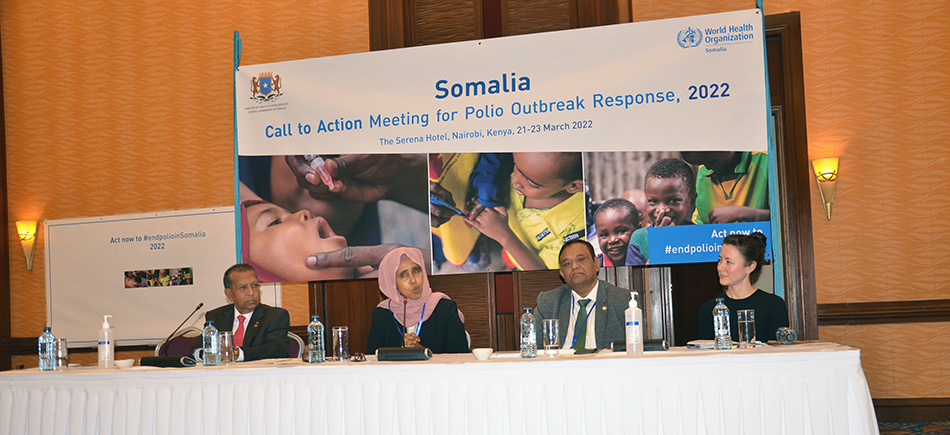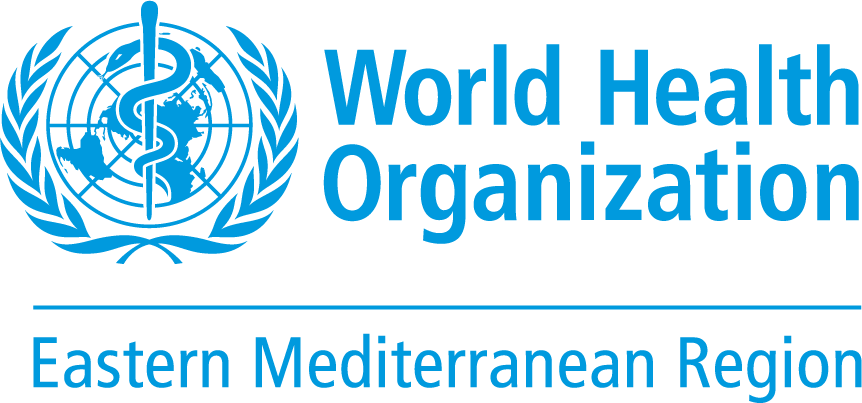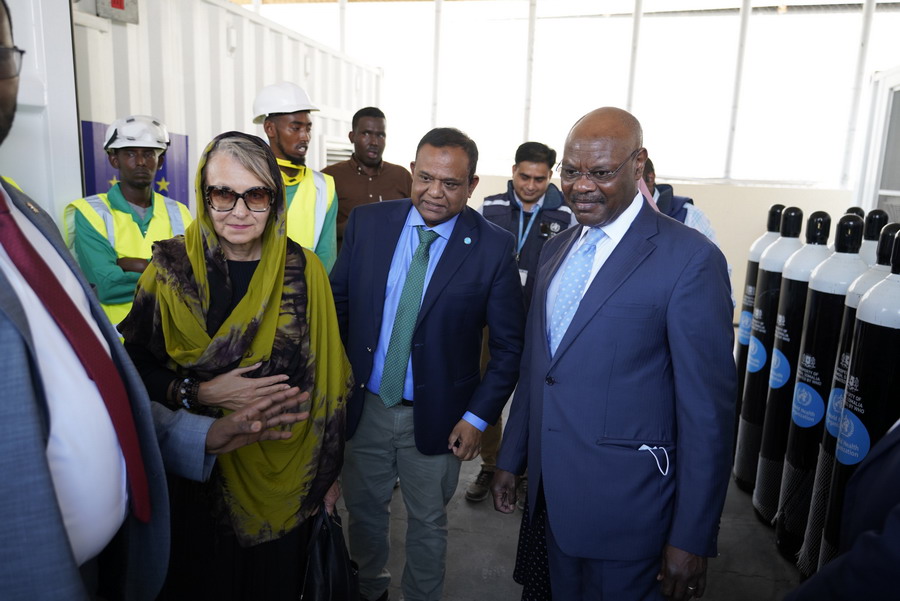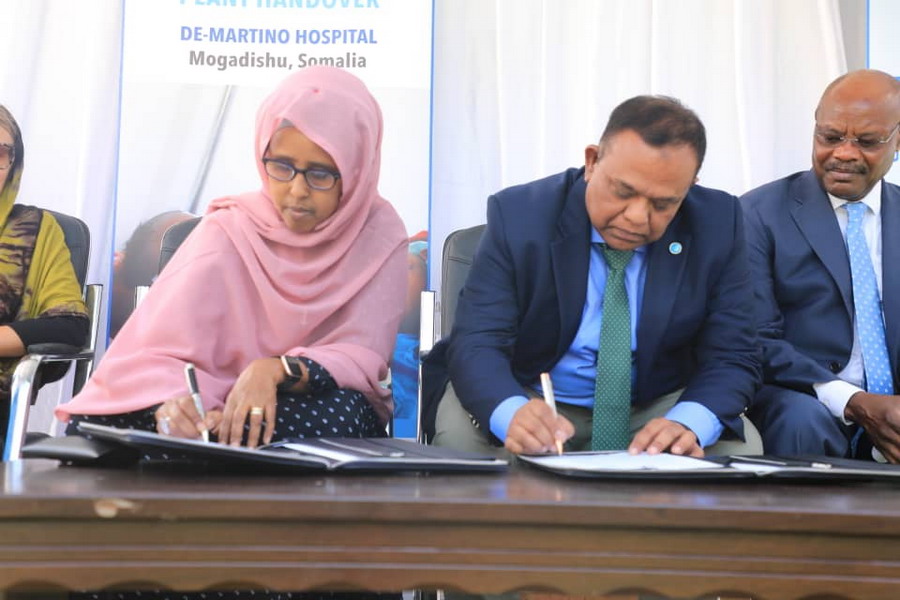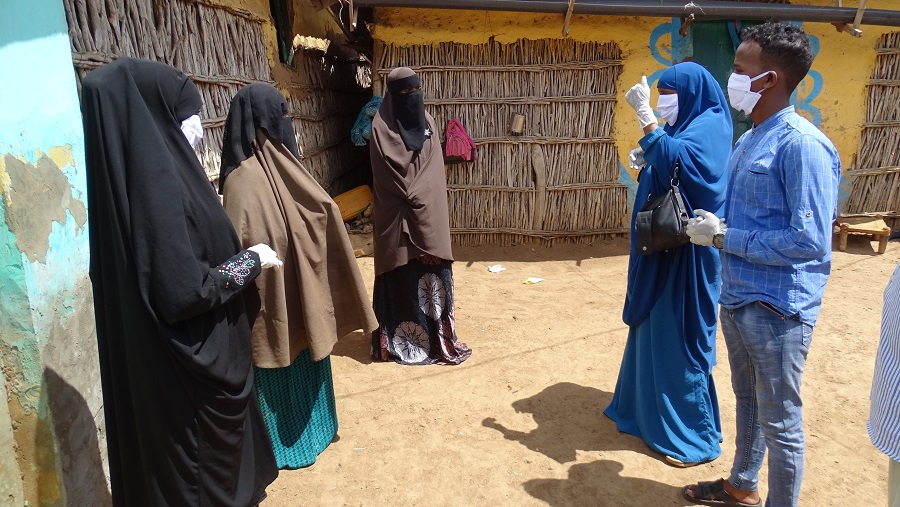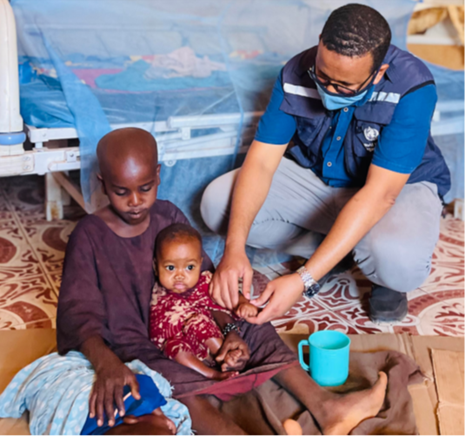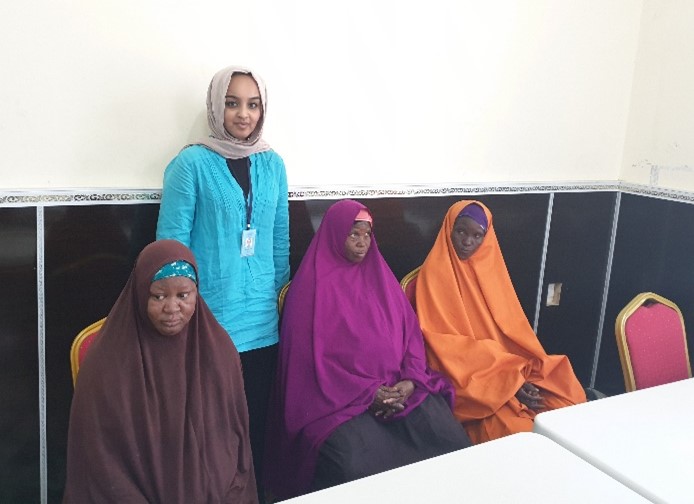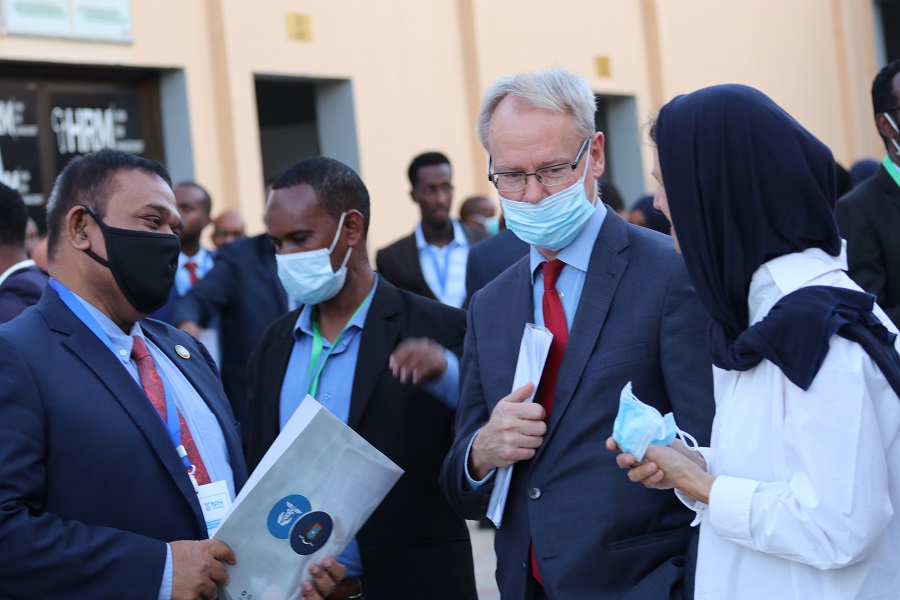 Dr Mamunur Rahman Malik, WHO Representative to Somalia, in discussion with HE Per Lindgarde, Ambassador of Sweden to Somalia. Credit: WHO/Mukhtar
Dr Mamunur Rahman Malik, WHO Representative to Somalia, in discussion with HE Per Lindgarde, Ambassador of Sweden to Somalia. Credit: WHO/Mukhtar
19 February 2022 – The COVID-19 pandemic has accentuated the importance of health research in finding solutions to health challenges. To address the most urgent health priorities using evidence-based solutions, the Ministry of Health and Human Services of the Federal Government of Somalia and National Institute of Health (NIH), with support from the World Health Organization (WHO) and other partners, convened the first ever health research conference in Garowe, Puntland, from 30 January to 1 February 2022.
Some of the brightest Somali minds came together at the event ─ 200 national and international researchers ─ to present 51 unpublished research abstracts, showcasing new evidence and best practices around public health actions in Somalia which were neither researched before in the country by anyone nor had any evidence been generated before on these priority public health issues. Overall, Somali authors submitted 91 abstracts; the rest were either published already or did not meet the expected criteria.
Dignitaries who participated in the conference included: HE Dr Fawziya Abikar Nur, Federal Minister of Health and Human Services; HE Dr Jama Farah Hassan, Minister of Health, Puntland; HE Per Lindgarde, Ambassador of Sweden to Somalia; Dr Mamunur Rahman Malik, WHO Representative to Somalia and Head of Mission. Representatives from the Swedish International Development Cooperation Agency (SIDA), the Public Health Agency of Sweden (PHAS) and African Field Epidemiology Network (AFENET), and colleagues from the University of Umea and the Gothenburg University in Sweden also participated.
Professor Khalif Bile, Chair of the NIH Board of Directors and the Scientific Committee for the NIH Research Conference, spearheaded the event, taking it from an idea to reality. Under the leadership of Dr Abdifatah Diriye Ahmed, NIH Executive Director, the NIH Public Health Specialist and research focal person, Dr Mukhtar Bulale, organized the conference, bringing together all relevant stakeholders.
 High-level dignitaries, including both the Federal and Puntland's Health Ministers with the WHO Representative, Ambassador of Sweden and NIH Executive Director, attended the research conference. Credit: WHO/Mukhtar
High-level dignitaries, including both the Federal and Puntland's Health Ministers with the WHO Representative, Ambassador of Sweden and NIH Executive Director, attended the research conference. Credit: WHO/Mukhtar
Institutions supporting the NIH
WHO extended financial support to the conference, through the Alliance for Health Policy and System Research (AHPSR), which aims to build health systems research capacity for low and middle-income countries and use new knowledge and evidence from public health research to set policies that support system building. The AHPSR promotes the generation and use of health policy and systems research to improve health systems in low- and middle-income countries, such as Somalia, while developing the research capacity of institutions, systems and individuals.
Other partners of WHO supporting this first ever research conference include the PHAS, which provided financial support to the event, and collaborates with the NIH, in addition to AFENET and SIDA, which offer regular technical support to the NIH’s activities.
Members of academia from 32 public, private and international universities attended the conference, and supported the NIH team at various stages of planning and implementation.
Young, budding Somali researchers light glimmer of hope
Participants at the conference included scientific and technical committees, organizers, presenters, stakeholders, panelists and partners. The scientific committee for the event assessed abstracts, mentored some of the authors whose abstracts needed further refining, and developed guidelines and checklists for peer reviewing the studies.
Of the 51 researchers, seven were female. Additionally, 10 trainees from the first ever Frontline-Field Epidemiology Training Program (FETP-Frontline) conducted in Somalia in 2021, with support from WHO, the PHAS, AFENET and the United States Centers for Disease Control and Prevention (US CDC), offered support to conduct the research conference.
Sadia Hussein, one of the two trainees from the first FETP cohort who presented an abstract, and a WHO Public Health Specialist, explained that she got the idea for her study while she was working in Deynile, Banadir, as part of the FETP field work. She added she enjoyed participating in the conference as it was a forum where researchers and experts came together with policy-makers to display their research skills, while highlighting gaps in the health system, and linking research to the bigger picture in health.
Researchers presented on an extensive range of topics
Researchers presented their findings on six themes that had been selected after taking into consideration the Essential Package of Health Services (Somalia EPHS 2020), universal health coverage (UHC) and Sustainable Development Goals (SDGs). They presented 10 abstracts under the theme of health systems; 15 as part of reproductive, maternal, newborn, child and adolescent health; 18 under communicable diseases; and 8 as part of noncommunicable diseases. Panelists delivered 12 informative presentations related to the themes of health research production and dissemination; and research training and capacity-building, linking research to action.
Presenters stimulated thought-provoking discussions between the sessions, including around strengthening pharmacovigilance and drug regulation; increasing and motivating human resources for health; occupational safety of health workers with the introduction of new diagnostics, improving access to health care for women; and providing compassionate care while maintaining dignity and the privacy of female patients. They discussed how to reduce and eliminate the harmful practice of female genital mutilation (FGM); and recruit assistant community-based midwives to improve maternal health care in rural areas. The only experimental study that was presented focused on ‘Effects of the Coenzyme Q10 on the Peripheral Nerve Injury: An Electrophysiological Study’, presented by a university professor.
Furthermore, participants debated over how to address the high burden of multi-drug resistant tuberculosis in Somalia, and the need to deploy community health workers to enhance early detection of the disease, in order to reach the SDGs’ target of ending tuberculosis epidemics by 2030. These rich discussions aim to spur changes in policies and programming eventually.
Introduction of the first Somali Health Action Journal
As another significant milestone, the NIH Board of Directors launched the Somali Health Action Journal (SHAJ) at the conference. This is the first Somali health journal that will receive articles, facilitate their review by peers, motivate Somalis to conduct further research, write and publish new articles, and take up opportunities to disseminate and use research for policy-making and the design of useful programmes.
The editors of the journal committed to supporting young Somali researchers by mentoring them where possible. The journal aims to inspire the young and future generations of Somali health professionals to study different topics that will lead to innovations in health in the country.
Research must address country’s problems
HE Dr Fawziya Abikar Nur, Minister of Health and Human Services for Somalia, praised the NIH, its board of directors, and scientific committees for motivating several young Somalis to present their findings on crucial health topics.
“I encourage you to document these national efforts ─ both what works and what does not work and why ─ but, above all, provide us solutions that can address the challenges we face,” she said, while thanking the partners who made the event a resounding success.
While lauding the Government of Somalia for its exemplary role in organizing a milestone event of this kind, and commending international researchers for visiting Puntland for the historical gathering and partners such as the PHAS for their support, Dr Mamunur Rahman Malik inspired young and experienced Somali researchers by announcing that WHO will work with the NIH to introduce state-of-the-art libraries in all ministry of health buildings of Somalia. He also added the WHO would award the young researchers nominated by the NIH for the best research presented in future conferences.
Dr Malik reminded the audience that in 1990, it was noted that only 10% of global health research was allocated for addressing 90% of global health problems. A commission set up to address this problem warned that if this disparity was not changed, the world would experience a large burden of infectious diseases, increasing rates of tuberculosis, malaria, and epidemics of noncommunicable diseases including heart diseases. As predicted, Dr Malik explained, the world is now seeing a high burden of these diseases, including infectious and noncommunicable diseases.
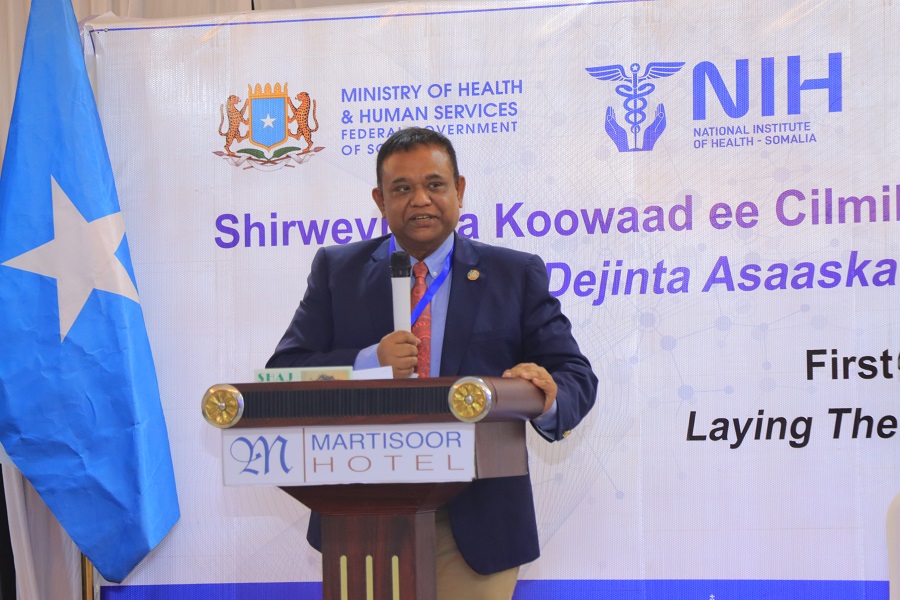 Dr Mamunur Rahman Malik, WHO Representative to Somalia addresses the researchers and participants at the research conference. Credit: WHO/Mukhtar
Dr Mamunur Rahman Malik, WHO Representative to Somalia addresses the researchers and participants at the research conference. Credit: WHO/Mukhtar
“I encourage you to come up with a national health research agenda and improve collaboration between the public and private sector, especially universities,” said Dr Mamunur Malik. “Also, research needs to contribute to improving national health. For example, diarrhoea and malaria contribute to a high burden of diseases but people do not have access to health services. Research should help address issues like this, and how to improve access in fragile settings like in Somalia, address health inequities, and increase access to drugs so people lead healthier lives.”
Putting Somalia on the global research map
On behalf of the NIH team, Dr Mukhtar Bulale explained that the sessions were successful and led to rich discussions with questions being answered, which was a flagship symbol illustrating useful nationally owned health research.
“Even though we started small, this conference has put Somalia on the global research map. Seeing young researchers put their best foot forward has given us immense hope that Somalia’s health research development is undergoing a recovery phase. We saw at the conference a unity of purpose, solidarity and eagerness for research partnerships and solutions to challenges. I urge stakeholders to ensure we do not miss the opportunity to support these young, dynamic researchers,” Dr Bulale said.
At the end of the conference, the Federal Ministry of Health, NIH, and stakeholders advocated for sustained investment in health research to further promote the Essential Package of Health Services 2020, which would benefit the Somali population. They also resolved to promote health system research, linking it to public policy formulation, while ensuring it focuses on addressing existing barriers to health service delivery. This implies the development of a national research agenda to invest – attention, resources and skills – in research that will result in improved health outcomes for the populations, and thematic areas where more evidence is required to inform policies and strategies. Together, they also committed to foster cooperation between the public and private sector in health system research, and to promote the development of innovative technologies and approaches. The partners resolved to strengthen the links between evidence generation and health care provision, while calling on all national and international stakeholders to develop the capacity of learning institutions and to facilitate high-quality research in the country.
Note to editors
The World Health Organization (WHO) country office for Somalia, the Government of Sweden and the Public Health Agency of Sweden (PHAS) are providing support to Somalia’s Federal Ministry of Health and Human Services (FMOH) to support the establishment and strengthening the capacity of the National Institute of Health (NIH) of Somalia. Please below articles for additional information on this exemplary collaboration.
Additional information on the Alliance for Health Policy and System Research
